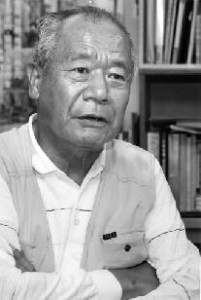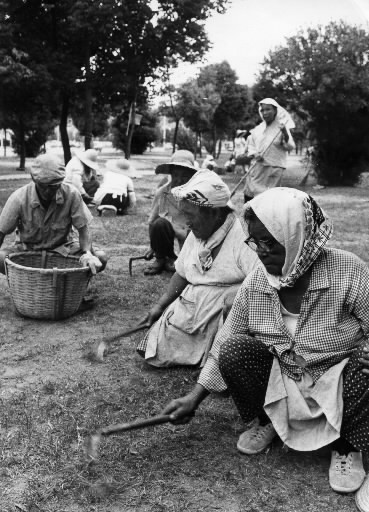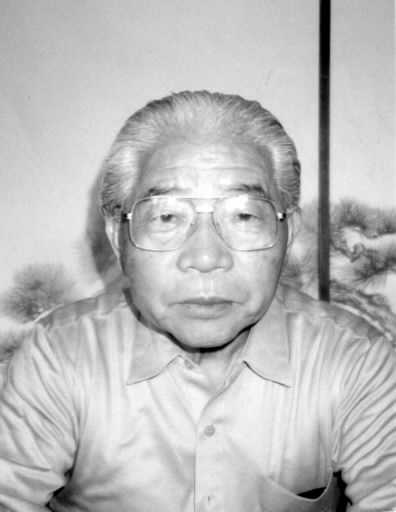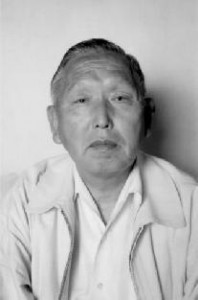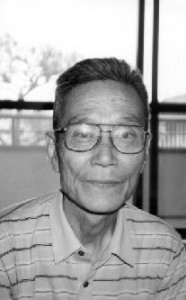History of Hiroshima: 1945-1995 (Part 20, Article 2)
Mar. 11, 2013
Labor unions
by Masuhei Ono, Senior Staff Writer
Note: This article was originally published in 1995.
Tracing the history of the campaign against atomic and hydrogen bombs, as well as the A-bomb survivors’ movement, religious organizations and labor unions, which helped sustain these efforts behind the scenes, are a regular presence. Among these religious organizations, the Buddhist order “Nipponzan Myohoji,” or the “Japan Buddha Sangha,” stands out prominently. Serving quietly and tirelessly in their yellow robes, the monks of this order bear drums shaped like round paper fans. Through its nonviolent action, the Nipponzan Myohoji Order opened a new horizon for the peace movement in Japan’s Buddhist society. Also making important contributions to these causes have been Quakers and Christians, largely Roman Catholics, who devoted themselves to relief efforts for the survivors of the atomic bombing in the aftermath of the attack and have made persistent appeals for the abolition of nuclear weapons.
Meanwhile, among labor unions, the Hiroshima branch of today’s All Japan Construction, Transport and General Workers’ Union is noteworthy for the activities that have amounted to efforts to provide support to A-bomb survivors. In these efforts, one leader lived his postwar life together with workers enrolled in the city’s relief program for the unemployed. Major labor unions in Hiroshima, which formed A-bomb survivors’ organizations within company unions and set the quest for peace and relief for A-bomb survivors as main pillars of their union movement, also played a large role. The Chugoku Shimbun looks back at representatives of these religious organizations and labor unions.
Striving to support A-bomb survivors
In the past, the weakest members of Japanese society--those who bolstered Japan’s economic prosperity from the bottom--joined hands in labor unions in an effort to protect their livelihoods. This labor union is now set to finish fulfilling one of its historical roles.
At its peak, about 30 years ago, the Hiroshima branch of today’s All Japan Construction, Transport and General Workers’ Union had as many as 7,600 members, and more than half were A-bomb survivors. Those who signed up to participate in the City of Hiroshima’s Work Relief Project, the Work Relief Project workers, formed the union branch to safeguard their lives and their rights.
The Work Relief Project was welcomed by A-bomb survivors, who were suffering ill health and fatigue (the so-called “A-bomb lazy disease”) from the effects of the bombing. The project provided mainly light work, such as cleaning up streets or weeding in parks, yet was a lifesaver for those who found it hard to hold a full-time job, particularly female survivors and the elderly.
Jihei Yoshida, 72, a resident of Minami Ward, has held the three most important positions in the Hiroshima branch of the current All Japan Construction, Transport and General Workers’ Union over the past 45 years, starting in 1950. He still serves as the head of the Hiroshima branch.
“I haven’t consciously been working for A-bomb survivors at all,” Mr. Yoshida said. “As a union, we have long demanded a chance to live, eat, and work, which eventually brought support to A-bomb survivors at the very bottom of the social ladder.” Interviewed at the union’s prefabricated building in the Mitaki district in Nishi Ward, Mr. Yoshida looked back on the Hiroshima branch’s 45-year history, during which the union movement was directly connected to relief activities for A-bomb survivors and other war victims.
Mr. Yoshida graduated from Chuo University earlier than originally scheduled and went off to war. He was in Kyushu when he heard the news of the August 6 atomic bombing of Hiroshima. On August 13, he was dispatched to Kanagawa Prefecture to receive weapons from an arms depot there. Two days later, he arrived in Hiroshima.
The city, he recalled, was a burnt plain as far as the eye could see. The green hometown of his memory had been turned into a charred town of death. When he dug through the ruins of the fire that had razed the Kaminobori district, where his house had once stood, he discovered a handful of large bones and two handfuls of smaller bones. These were the bones of his mother and his twin sisters, aged 12 at the time. Placing their bones in a small bag that attached to his waist, he then heard the Emperor announce the end of the war in a radio broadcast that was difficult to make out. “The war ended too late...” thought Mr. Yoshida, feeling only a great emptiness.
Eleven days later, on August 26, another younger sister, who had been wounded in the bombing, died in agony at a relative’s house. His mother had lost his father early in their marriage and she had raised as many as ten children by herself. His three sisters who had died, too, were still so young in years. In the face of their unjust deaths, “I felt that the path I should follow was laid out to me all on its own,” he said.
This resolve would form a big part of his life from that point on. In September of 1945, when people still held vivid memories of the bombing, Mr. Yoshida landed a job at the Chugoku Shimbun, the Hiroshima-area newspaper. More than 100 employees of the Chugoku Shimbun had lost their lives in the blast. In June of the following year, he was assigned to the newly-established “Evening Edition Hiroshima.” While working as a copy editor, he helped organize a labor union and took up the post of secretary general.
“We were hungry back then, but a sense of liberation filled us up,” Mr. Yoshida recalled. “While we were determined to prevent another war, our main aim was to protect the livelihoods of our members.” At a coffee shop rebuilt near the Chugoku Shimbu building amid the charred ruins of the city, he and his colleagues would gather and discuss their youthful dreams.
In November 1948, he was recommended for the post of secretary general of the Hiroshima Prefectural Trade Council, then the sole unified association of labor unions in Hiroshima Prefecture. However, two years later things took a harsh turn for the worse. Following the outbreak of the Korean War, the General Headquarters of the Allied Powers (GHQ) launched the “Red Purge,” a crackdown on communist party members and supporters.
Mr. Yoshida, along with 20 of his fellow workers, was driven from the Chugoku Shimbun. He appealed to the Hiroshima Local Labor Relations Commission for a reversal of this dismissal and “won a nominal victory, but lost in reality.” Although the judgment was made, four years later, to nullify the dismissal, by then the “Evening Edition Hiroshima” had already discontinued publication.
In August of the year he was discharged from the newspaper company, he signed up for the Work Relief Project, an effort by the City of Hiroshima to provide employment, and figured he would take part in this work for three months at the longest. As long as he was appealing his dismissal at the Hiroshima Local Labor Relations Commission, he was unable to seek employment at other companies.
When he entered the world of the Work Relief Project, Mr. Yoshida found that it was far more unruly than he had heard about or could have imagined. A man with brute physical strength seized an easy task and stole the wages of two or three others. Bossism was rampant. The bureaucracy of the system, which should have ensured fairness, held no sway.
“I couldn’t stand by and watch any longer,” Mr. Yoshida said. “The older folks begged me to look after them as well, and my sympathy for them got the better of me.” In December of that year, he helped organize a meeting to rebuild the Hiroshima Union for Free Laborers, which had become defunct, and he was chosen chief secretary. In 1953, as soon as the forerunner of the All Japan Construction, Transport and General Workers’ Union, a nationwide organization, was formed, he was asked to assume the role of first secretary general. His ties to the organization have continued ever since, like it or not.
There were many voices amid the union movement making such small requests as “On New Year’s Day, I’d like to eat a rice cake, at least” and “I want the Work Relief Project to provide more job opportunities.” These requests, impelled by the hand-to-mouth existence of the union members, were imbued with their heartfelt wishes for the minimum conditions of a humane life.
The late Dr. Kiyoshi Shimizu, former director of a nursing home for A-bomb survivors, wrote in his book entitled “Genbaku Koro” (“Lonely Old A-bomb Survivors”): “The A-bomb free laborers lost all their property as a result of the atomic bombing and engaged in day labor for their survival by making use of their labor, their only remaining asset. But as their bodies were damaged by the bombing, even their labor was compromised. Many of them didn’t heed their doctors’ advice and, despite poor health, went on working to earn their daily bread, thus shortening their lives.”
The late Chika Kashima, who lost her eldest daughter to the atomic bomb, offered her testimony in a collection of writing about the atomic bombing entitled “Watashira no Hibaku Taiken: 100 Nin no Shogen” (“Our A-bomb Experiences: Testimonies of 100 people”), which was published by the Hiroshima branch of the forerunner of the All Japan Construction, Transport and General Workers’ Union in 1977: “All my blood relations have vanished from Hiroshima. My temple visits have become the only reason for me to go on. Because I’m alone, I have no choice but to work until the day I die.”
Ms. Kashima was 85 years old at the time she wrote these words. The reality was that, even at such an advanced age, she was forced to continue working in order to survive. In the face of such conditions, Mr. Yoshida felt he could not leave the union.
However, a plan to bring the Work Relief Project to an end was discussed as early as the Ikeda administration on such grounds as “those involved are growing older,” “the system is inefficient,” and “local municipalities are feeling financial pressures.” Behind this push lay the top priority of “efficiency,” a demand of the times, and the pursuit of high economic growth centering on the idea of doubling the national income.
In 1970, the City of Hiroshima provided a lump sum of 100,000 yen to each person registered in the Work Relief Project to help them prepare for future employment beyond the life of the project. The following year, the city implemented such measures as providing 350,000 yen to each person willing to give up his or her membership in the program within a certain period of time, and about 900 people withdrew. Afterwards, too, the Work Relief Project was scaled down further with members encouraged to retire and a system put in place to institute an age for retirement.
“At any time, more than half of the measures constituting the city’s Work Relief Project amounted to relief measures for A-bomb survivors. We repeatedly asked the city to understand that, but...” Mr. Yoshida’s voice trailed off as he reflected on that painful time. Their resistance was finally for naught, and, in line with national policy, the City of Hiroshima terminated the program at the end of 1993. At the end of March 1996, the central government, too, will bring the effort to an end, drawing a curtain on its 47-year history.
Under these circumstances, the membership of the Hiroshima branch of the forerunner of the All Japan Construction, Transport and General Workers’ Union has dropped sharply to 250, less than a thirtieth of the number at its peak. Now, those working for the “optional employment project,” a five-year provisional measure following the conclusion of the Work Relief Project, sustain the existence of the union.
A-bomb survivors, war repatriates from overseas, the elderly, women, and the weak... Mr. Yoshida has worked side by side with such people for half a century. At one point he was even arrested and served time in jail. “Throughout my life, I have been taught and supported by people working at the very bottom of the social pyramid,” he said. “I have never felt that my life has been long. I just did what I felt I should.” His tanned face, which radiates his strong will and vigor, does not show his age.
The shouts of elderly supporters from outside the police station where he was detained still echo in his head: “Give us back Yoshida! Give us back Yoshida!” The faces of each Work Relief Project member who bailed him out with a collection of one-yen coins remain etched in his mind.
Impact of A-bomb survivors’ organizations within company unions
A-bomb survivors’ organizations within company unions played a large role in shifting both the A-bomb survivors’ movement and the campaign against atomic and hydrogen bombs from instances of mobilizing people for particular occasions to a sustained, daily effort on the part of labor unions. The first A-bomb survivors’ organization within a company union was formed by the then National Railway Workers’ Union.
In July 1965, 20 years after the atomic bombing, Tetsuo Nakata, head of the Hiroshima District Headquarters, proposed a special resolution for relief activities for A-bombed workers at the national convention of the National Railway Workers’ Union, which was held in the city of Okayama. The resolution was adopted unanimously.
Takayuki Seto, 69, now vice chairman of the Hiroshima Prefectural Confederation of A-bomb Sufferers Organizations, affiliated with the Socialist Party, and then an executive committee member of the Hiroshima District Headquarters, drafted the resolution. Reflecting on that era, Mr. Seto said, “At the time, some employees were unable to come to work due to the aftereffects of the atomic bombing. I didn’t think this was something I could overlook, so I proposed to the union that we establish a ‘Section for A-bomb Survivors.’”
In response to this resolution, on June 18 of the following year the National Railway Workers’ Union formed a council for A-bomb survivors in the union and placed its office in the Hiroshima District Headquarters. According to a survey conducted by the Japan National Railway, the number of its A-bombed employees back then exceeded 2,000 nationwide.
A-bombed workers at the Japan National Railway, regardless of party affiliation, converged at the council for A-bomb survivors. Around that time, Akito Suemune, 68, secretary general of the other faction of the Hiroshima Prefectural Confederation of A-bomb Sufferers Organizations, comprised of members who were supporters of the Communist Party, then the minority in the Hiroshima District Headquarters, also formed a united front with Mr. Seto, a supporter of the Socialist Party, among others.
Then, in October of 1968, today’s All NTT Workers Union of Japan organized the liaison council of Hiroshima A-bomb survivors. The post of secretary general was taken up by Koshiro Kondo, 62, an assistant secretary general of the socialist-afflicted Hiroshima Prefectural Confederation of A-bomb Sufferers Organizations. Mr. Kondo had been actively engaged in issues involving A-bomb survivors for a long time.
The liaison council made vigorous efforts to improve the working conditions of A-bombed employees and also published a collection of writing about the atomic bombing entitled “Genshigumo no Shita ni Ikitsuzukete” (“Surviving Beneath the Atomic Cloud”), among other actions.
Subsequently, in response to a call by the council for A-bomb survivors of the National Railway Workers’ Union and the liaison council of Hiroshima A-bomb survivors of the current All NTT Workers Union of Japan, in 1972 seven organizations (later 13 organizations), including the Hiroshima Teachers’ Union and the two factions of the Hiroshima Prefectural Confederation of A-bomb Sufferers Organizations, gathered and launched an association to address the concerns of second-generation A-bomb survivors.
This association was significant in that the two factions of the Hiroshima Prefectural Confederation of A-bomb Sufferers Organizations sat at the same table for the first time since their split and the A-bomb survivors’ organizations within company unions stood up to take joint action beyond their corporate framework. The association evolved into the Hiroshima Alliance of A-bomb Survivor Organizations after a sit-in on July 20, 1973 to protest a French nuclear test.
Mr. Kondo, secretary-general of the liaison council of the forerunner of the All NTT Workers Union, was recommended for the post of secretary general of the Hiroshima Alliance of A-bomb Survivor Organizations. This move was made based on the belief that Mr. Kondo was the best person to serve as a mediator capable of bridging the various organizations involved. Though a full-time officer of the forerunner of the All NTT Workers Union, he had not joined the Socialist Party and had worked single-mindedly for the A-bomb survivors’ movement and the campaign against atomic and hydrogen bombs as an independent.
However, Mr. Kondo was dismissed from his position as a full-time officer of the forerunner of the All NTT Workers Union in 1976, probably because of his status as “an independent.” He said with a laugh: “A party member can’t help putting the interests of his party before the interests of the union. As I didn’t like this, I didn’t join a party. But in the end, I got kicked out of the organization.”
With the dissolution of Sohyo, or the General Council of Trade Unions in Japan, and a sweeping reorganization of the labor world, the orientation of labor unions toward the A-bomb survivors’ movement and the campaign against atomic and hydrogen bombs has come to an important turning point as well.
The nature of unions, many of which have permitted former full-time officers to become lawmakers or take up a managerial post at a union-affiliated organization, as well as the ties of unions to political parties, are now being called into question.
(Originally published on June 4, 1995)

